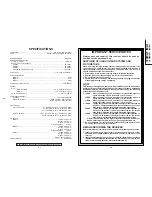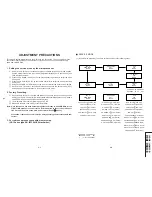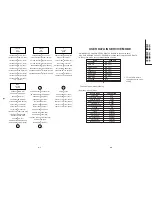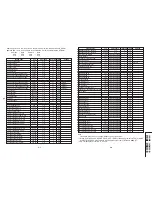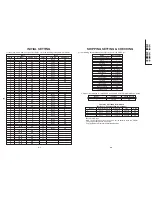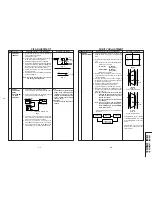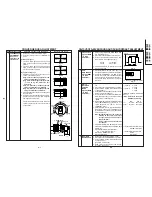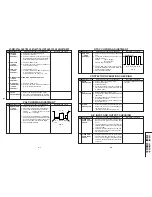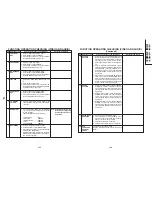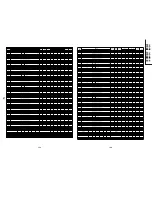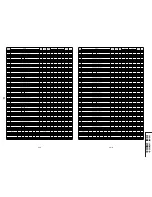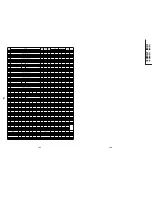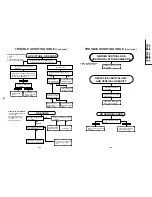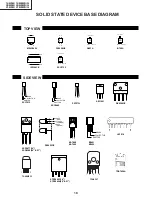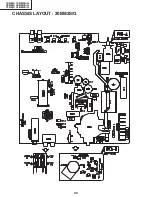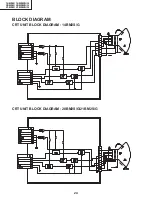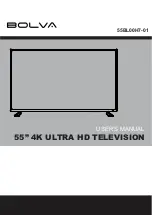
8
8-1
8-2
14BM2, 14BM2S/G
20BM2, 20BM2S/G
21BM2, 21BM2S/G
RGB
BGR
R
G
B
R
G
B
B
G
R
B
G
R
RGB
BGR
Lacquer
Wedge "a"
Wedge
"b"
Wedge
"c"
About
100
°
About
100
°
4-pole magnet
6-pole magnet
CRT neck
20cm
(21")
Lacquer
Purity magnet
40cm
(14")
CONVERGENCE ADJUSTMENT
NO. Adjustment part
Adjusting procedure and conditions
Waveform and others
1
CONVERGENCE
ADJUSTMENT
(To be done
after the purity
adjustment.)
1. Receive the “Crosshatch Pattern” signal.
2. Using the remote controller, call NORMAL
mode.
Static convergence
1. Turn the 4-pole magnet to a proper opening
angle in order to superpose the blue and red
colours.
2. Turn the 6-pole magnet to a proper opening
angle in order to superpose the green colour
over the blue and red colours.
Dynamic convergence
1. Adjust the convergence on the fringes of the
screen in the following steps.
a) Fig. 5-1: Drive the wedge at point “a” and
swing the deflection coil upward.
b) Fig. 5-2: Drive the wedge at points “b” and
“c” and swing the deflection coil
downward.
c) Fig. 5-3: Drive the “c” wedge deeper and
swing the deflection coil rightward.
d) Fig. 5-4: Drive the “b” wedge deeper and
swing the deflection coil leftward.
2. Fix all the wedges on the CRT and apply glass
tape over them.
3. Apply lacquer to the deflection yoke lock screw,
magnet unit (purity, 4-pole, 6-pole magnets)
and magnet unit lock screw.
Finally received the Red-only and Blue-only
signals to make sure there is no other colours
on the screen.
Fig. 5-2
Fig. 5-1
Fig. 5-3
Fig. 5-4
Fig. 5-5
Fig. 5-6
1. Call “SUB-BRI” in service mode. (Receive
Crosshatch pattern with 5 black level windows)
2. Adjust the “SUB BRIGHT” bus data in order
that the line 1, 2 and 3 have the same darkness
wherelse line 4 is slightly brighter than line 1,
2 and 3 and finally line 5 will be the brighter
than line 4.
1. Switch TV to VIDEO mode, BLUE BACK OFF,
with NO VIDEO signal.
2. Press R/C to set Picture Normal condition.
3. Connect the oscilloscope to Red OUT from
IC801.(TP851 (14")/TP852 (20"/21"))
Range
: 1 V/Div (DC)
Sweep
: 5 msec/Div
4. Adjust SCREEN VR, so that the tip of signal
reach 3.0
±
0.1 Vdc.
CRT CUT-OFF, BACKGROUND AND SUB-CONTRAST ADJUSTMENT
NO. Adjustment part
Adjusting procedure and conditions
Waveform and others
1
2
SUB-
BRIGHTNESS
ADJUSTMENT
(I
2
C BUS
CONTROL)
1, 2 and 3 are in same black level.
CRT CUTOFF
ADJUSTMENT
(I
2
C BUS
CONTROL)
Fig. 6
3
WHITE
BALANCE
SERVICE
MODE
ADJUSTMENT
(I
2
C BUS
CONTROL)
1. Receive the “WHITE” pattern with BURST sig-
nal.
2. Press R/C to set Picture NORMAL condition.
3. Connect the DC miliammeter between TP602
(-) and TP603 (+).
4. Check Beam current should be around 1,100
µ
A
(20"&21") (14" around 800
µ
A).
5. Set it to service mode and adjust the DRI-GS,
& DRI-BS data to have a colour temperature
of 12,300
°
K or 7,500
°
K (white).
* Note .
6. Receive “WHITE” pattern, WITH BURST signal,
and set BRIGHTNESS Y by generator, to ** 10
cd/m2 (MINOLTA CA-100) by reducing
LUMINATE Y signal.
7. Adjust “CUT-R” & “CUT-G” to get desired colour
temperature. Then go back NORMAL mode
(HIGH BRIGHT**) to check colour temperature.
If out 14” back to (1)
Note: This adjustment must be done after
warming up the unit for 30 minutes
or longer with a beam current over
700
µ
A. (20"&21")
(For 14", the beam current should be
over 500
µ
A)
* Adjust DRI-GC/GW, DR-BC/BW as following
data, after finishing DRI-BS and DRI-GS data
adjustment.
DRI-RW=32 (FIXED), DRI-GW=”DRI-
GS”-7*, DRI-BW=”DRI-BS”-7*
DRI-RC=25, DRI-BC=”DRI-BS”,
DRI-GC=”DRI-GS”-7*
Refer to Page ????.
* 12,300
°
K
X : 0.272
Y : 0.275
* 18,000
°
K
X : 0.255
Y : 0.255
(MINOLTA COLOUR ANALYZER
CA-100)
*Note: Above Data can be UP/
DOWN by Volume key.
LOW
HIGH
14"
10 cd/m2
200 cd/m2
20"/21" 10 cd/m2
120 cd/m2
* 12,300
°
K DRI-GW=”DRI-GS”-7
DRI-BW=”DRI-BS”-7
* 18,000
°
K DRI-GC=”DRI-GS”
DATA-5
DRI-RC=27
4
MAXIMUM
BEAM CHECK
1. Receive the “Monoscope Pattern” signal.
2. Press R/C to set Picture NORMAL condition.
3. Connect the DC miliammeter between TP603
(+) and TP602 (–).
(Full Scale: 3 mA Range)
4. Beam current must be within 1,100
±
100
µ
A
(21") 800
±
100
µ
A(14") .
1 V
3.0Vdc
0
1 2 3 4 5
Fig. 7


